Pogonomyrmex anzensis
| Pogonomyrmex anzensis | |
|---|---|

| |
| Scientific classification | |
| Kingdom: | Animalia |
| Phylum: | Arthropoda |
| Class: | Insecta |
| Order: | Hymenoptera |
| Family: | Formicidae |
| Subfamily: | Myrmicinae |
| Tribe: | Pogonomyrmecini |
| Genus: | Pogonomyrmex |
| Species: | P. anzensis |
| Binomial name | |
| Pogonomyrmex anzensis Cole, 1968 | |
An unusual member of the genus in its habitat preference, rocky and steep slopes, and its relative docile nature.
Identification
This species has been assigned to the occidentalis complex, although the characters which determine this assignment are not so definitive as could be desired. It may be a member of the maricopa complex. The conformation of the mandible and paramere of the unknown male should ultimately determine the proper position. During the summer of 1960 I was unable, despite an intensive search, to find specimens at or in the vicinity of the type locality. P. anzensis is unique among its closest relatives in having only 6 teeth in the mandible of the worker. The absent tooth is apparently the ultimate basal, for the basalmost tooth, though not minute, is definitely shorter than the adjoining one, whereas in other members of its complex the basal most (ultimate basal) tooth is distinctly longer than the adjacent one (penultimate basal). Other distinctive features of the workers are the carinate posterior corners of the head and the prominent, narrow, ventral, postpetiolar process. (Cole 1968)
Keys including this Species
Distribution
United States. San Diego County, California. Known from Anza-Borrego Desert State Park, Ocotillo Wells Recreational Vehicle Area and a few locations adjacent to these areas.
Latitudinal Distribution Pattern
Latitudinal Range: 33.46666667° to 33.001606°.
| North Temperate |
North Subtropical |
Tropical | South Subtropical |
South Temperate |
- Source: AntMaps
Distribution based on Regional Taxon Lists
Nearctic Region: United States (type locality).
Distribution based on AntMaps
Distribution based on AntWeb specimens
Check data from AntWeb
Countries Occupied
| Number of countries occupied by this species based on AntWiki Regional Taxon Lists. In general, fewer countries occupied indicates a narrower range, while more countries indicates a more widespread species. |

|
Estimated Abundance
| Relative abundance based on number of AntMaps records per species (this species within the purple bar). Fewer records (to the left) indicates a less abundant/encountered species while more records (to the right) indicates more abundant/encountered species. |

|
Biology
Nests are atypical for the genus. One was found "located next to a partially buried large stone and consisted of a single unmarked opening and virtually invisible chaff pile which was somewhat reminiscent of nests of P. apache, but was even more diffuse. Several other nests were finally located confirming that this was typical rather than an anomaly." [Snelling 2002]
Snelling et al. (2009) - Nest entrances are typically unmarked by a crater, although on occasion there may be a small dispersed amount of chaff or soil, barely discernable from the surrounding litter on the ground. Nest entrances are usually, but not always, situated adjacent to a large rock. During the course of collecting, a few colonies were located in which the nest entrance was just a simple hole in the soil. Workers forage singly and are slow-moving and timid. Workers were noted often to tuck their gasters under the mesosoma when foraging. The ants make little effort to defend the nest when disturbed other than running around somewhat excitedly, then retreating. Although there are several other harvester ants in the general area, (Pogonomyrmex californicus, Pogonomyrmex magnacanthus, Pogonomyrmex rugosus and Messor pergandei), these species all nest and forage primarily in the wash and on the lower hillsides. By nesting in these extreme habitats, P. anzensis avoids most of the foraging competition from other harvester ant species in the area. M. pergandei will often forage onto the hillside but generally at times of the day when P. anzensis is not active. Other ants occurring with P. anzensis on the hillside are Pheidole hyatti, Pogonomyrmex imberbiculus and a large diurnal Myrmecocystus species, most likely Myrmecocystus mendax , a common inhabitant of rocky localities in Southern California.
Little is known about the foraging preferences of this ant species. However it is presumably a generalized seed collector and scavenger like its congeners.
Castes
Wprker
Images from AntWeb
   
| |
| Worker. Specimen code casent0179510. Photographer Erin Prado, uploaded by California Academy of Sciences. | Owned by MCZ. |
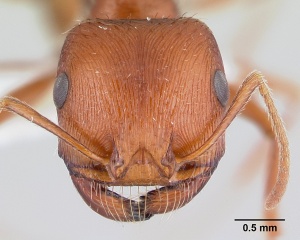   
| |
| Worker. Specimen code casent0179511. Photographer Erin Prado, uploaded by California Academy of Sciences. | Owned by MCZ. |
  
| |
| Worker. Specimen code casent0005714. Photographer April Nobile, uploaded by California Academy of Sciences. | Owned by UCDC, Davis, CA, USA. |
Queen
Images from AntWeb
 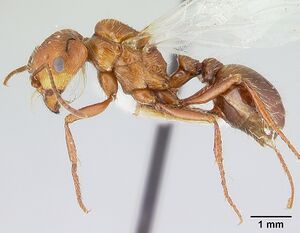  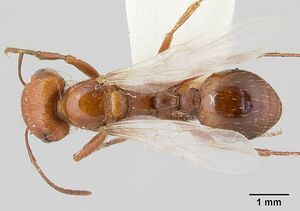 
| |
| Queen (alate/dealate). Specimen code casent0179513. Photographer Erin Prado, uploaded by California Academy of Sciences. | Owned by MCZ. |
Male
Images from AntWeb
 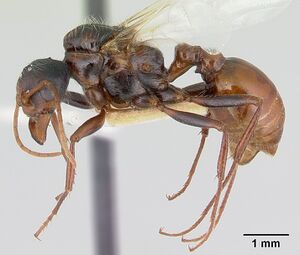 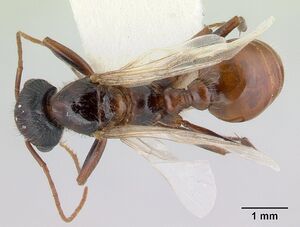
| |
| Male (alate). Specimen code casent0179514. Photographer Erin Prado, uploaded by California Academy of Sciences. | Owned by MCZ. |
  
| |
| Queen (alate/dealate). Specimen code casent0179513. Photographer Erin Prado, uploaded by California Academy of Sciences. | Owned by MCZ. |
Nomenclature
The following information is derived from Barry Bolton's Online Catalogue of the Ants of the World.
- anzensis. Pogonomyrmex (Pogonomyrmex) anzensis Cole, 1968: 87, pl. 3, fig. 13; pl. 4, fig. 11; pl. 6, fig. 12; pl. 7, fig. 15 (w.) U.S.A. Snelling, R.R. et al. 2009: 316 (q.m.).
Unless otherwise noted the text for the remainder of this section is reported from the publication that includes the original description.
Description
Worker
Holotype. HL 1.60 mm, HW 1.63 mm, CI 101.9, SL 1.28 mm, SI 78.5, EL 0.37 mm, EW 0.23 mm, OI 23.1, WL 1.72 mm PNL 0.54 mm, PNW 0.54 mm, PPL 0.36 mm, PPW 0.51 mm.
Mandible with only 6 teeth, the seventh tooth (ultimate basal) evidently aborted; sixth tooth (penultimate basal) distinctly shorter than fifth (third basal); fourth tooth (second basal) notably shorter than third (first basal); all teeth sharp. Apical margin of blade broadly and weakly convex; basal margin short, nearly straight.
Base of antennal scape as illustrated in Pl. IV, Fig. 11; shaft moderately and evenly curved in basal half, not flattened nor notably constricted along the bend. Basal enlargement weak; superior lobe with apex subacute; superior declivity long, low, meeting the shaft evenly without an obtuse angle; inferior declivity steeper, meeting the shaft evenly at a weak but distinct, rounded angle; basal flange narrow, thin, curved distad, the margin somewhat thicker along superior lobe from the apex of which it extends distinctly outward for a short distance at a pronounced angle with the apex; lip rather weak, extending for only a short distance outward where it distinctly but rather weakly curves distad, the distal portion short, the curvature smooth, not sharply angular; longitudinal peripheral carina distinct, rather weak, continuing beneath that part of inferior lobe under the lip where it ends, thus forming a weak, well-rounded point; outer lateral surface of inferior lobe not notably depressed, not flattened.
Head, viewed from above, with each occipital corner bearing a prominent, longitudinal, strongly carinate ruga well set off from outer portion of occipital corner. Cephalic rugae coarse rather widely spaced, strongly divergent into posterior corners, forming prominent, regular whorls above the eyes; interrugal spaces shining, faintly, irregularly, and rather sparsely punctate. Frontal area with a single, strong, median, longitudinal carina.
Contour of thorax, petiole, and post petiole as shown in Pl. VI, Fig. 12; epinotum with a pair of distinct, short angles; episternal flanges very weakly developed. Thorax strongly rugose, the rugae coarse, widely spaced, arcuately transverse on pronotum, longitudinal on mesonotum, transverse on epinotum, especially coarse and prominent on sides of epinotum; interrugal spaces strongly shining, faintly and sparsely punctate. In lateral view, venter of petiolar peduncle with a prominent, triangular, punctate lobe; postpetiolar venter with a prominent, narrow, triangular, subacute process and just anterior to it a much smaller process. Contours of petiole and postpetiole, viewed from above, as shown in Pl. VII, Fig. 15. Petiolar and postpetiolar nodes opaque, densely and moderately strongly punctate; viewed from above, weakly, irregularly, transversely rugulose in posterior half. Gaster shining, base of first segment densely and finely shagreened.
Head, thorax, petiole, and postpetiole uniform, medium, ferrugineous red; gaster and appendages somewhat lighter, more brownish.
HL 1.52-1.60 mm, HW 1.52-1.63 mm, CI 100.0-101.8, SL 1.18-1.25 mm, SI 76.7-77.6, EL 0.37-0.38 mm, EW 0.23-0.23 mm, OI 23.5-25.0, WL 1.52-1.75 mm, PNL 0.30-0.38 mm, PNW 0.30-0.38 mm, PPL 0.34-0.12 mm, PPW 0.46-0.53 mm.
Queen
Snelling et al. (2009) - Measurements (mm) (n 5 1). HL 1.79; HW 1.87; SL 1.33; EL 0.41; EW 0.31; OMD 0.53; WL 2.44; TL ca. 6.80. Indices. CI 104; SI 74; OI 23.
Small, scarcely larger than large conspecific workers. Mandibles as described above, dorsal surfaces coarsely striate, strongly shining. Head in full-face view slightly broader than long, posterior corners abruptly rounded, almost angulate, posterior margin flat. Dorsum and sides of head conspicuously rugose, in side view rugae forming circumocular whorls posterior to the eye, interrugular spaces smooth and strongly shining. Antennal scape short, failing to reach the posterior margin by at least twice its maximum diameter. Psammophore welldeveloped. Mesoscutum as described above. Most of pronotum smooth and shining, but with several strong rugae that extend from the lower pronotal sides to nearly the midline on the pronotal collar. Katepisternum finely rugulose, interrugal spaces roughed, less shiny than those on most of the rest of the mesosoma, some coarse, decumbent pubesence present at least on the posterior surfaces, weakly to moderately shining. Propodeum unarmed, rounded to subangulate, sides and dorsal surface rugose, shining, posterior surface smooth and strongly shining. Petiole without anteroventral process, ventral surface glabrous. In side view, node with moderately sharp apex, posterior surface slightly convex, weakly rugulose, interrugular spaces roughened and only moderately shiny. Postpetiole in side view with low, rounded node, a small anterior-facing denticle just ventral to the petiolar articulation, and a well developed ventral tooth. Gastric tergites smooth and shining, with weak tessellated microscuplture, and scattered coarse setae-bearing punctures. Body surfaces in general with moderately abundant coarse erect to suberect setae.
Male
Snelling et al. (2009) - Measurements (mm) (n 5 10). HL 1.37; HW 1.50; SL 0.93; EL 0.47; EW 0.33; OMD 0.20; WL 2.45; TL ca. 7.20. Indices. CI 109; SI 62; OI 31.
Mandible with four teeth on strongly oblique masticatory margin; tip of subbasal tooth sometimes weakly bifid; basal tooth not offset. Anterior margin of clypeus broadly and shallowly concave. Scape long, in repose nearly attaining level of posterior margin as seen in full frontal view. Pilosity suberect to erect, long hairs of vertex mostly straight, longest slightly curled apicad, not much, if any, exceeding eye width; scape hairs all short and decumbent, all shorter than minimum scape width. Cephalic rugae fine and close, slightly wavy, interspaces weakly punctate and moderately shiny.
In profile, anterior face of pronotal collar straight and oblique. Anterior face of mesonotum straight and not overhanging pronotum, about one-half as long as dorsal surface. Propodeum evenly curved to broadly subangulate in profile, without spines or denticles. Side of pronotal collar with fine superficial rugulae, especially laterad; mesepisternum with fine irregular, mainly longitudinal rugulae and superficially shagreened; mesonotum shiny between scattered coarse piligerous punctures; propodeum mostly with fine close punctures, but with variable smooth shiny areas, especially mesially. Tibiae with suberect hairs that are much shorter than tibial width.
Petiole without anteroventral process; node rounded in profile, broadly and evenly rounded into anterior peduncle; venter glabrous. Postpetiole node low and broadly rounded, anterior slope about three times as long as posterior slope. Disc of gastral tergum 1 (abdominal tergum 4) smooth, shiny and impunctate; following segments similar but with scattered minute piligerous punctures. Tergum 1 largely bare, with sparse short hairs basad on each side; following segments with sparse short and medium-length hairs, especially at segment margins; sterna only slightly more pilose, second segment with short straight hairs on disc.
Type Material
Type locality. Split Mountain, Anza Desert State Park, California, April 22, 1952, W. S. Creighton leg. The type series consists of the Holotype and 29 paratype workers.
The Holotype and 12 paratypes are in my collection. The remaining paratypes will be deposited in the U. S. National Museum, the Museum of Comparative Zoology, and the collection of Dr. Creighton.
References
- Cole, A. C., Jr. 1968. Pogonomyrmex harvester ants. A study of the genus in North America. Knoxville, Tenn.: University of Tennessee Press, x + 222 pp. (page 87, pl. 3, fig. 13, pl. 4, fig. 11; pl. 6, fig. 12; pl. 7, fig. 15 worker described)
- Parker, J.D., Rissing, S.W. 2002. Molecular evidence for the origin of workerless social parasites in the ant genus Pogonomyrmex. Evolution 56: 2017-2028.
- Schmidt, J. O. and G. C. Snelling. 2009. Pogonomyrmex anzensis Cole: Does an unusual harvester ant species have an unusual venom? Journal of Hymenoptera Research. 18:322-325.
- Snelling, R. R.; Snelling, G. C.; Schmidt, J. O.; Cover, S. P. 2009. The sexual castes of Pogonomyrmex anzensis Cole (Hymenoptera: Formicidae). Journal of Hymenoptera Research 18:315-321. [2009]
References based on Global Ant Biodiversity Informatics
- Johnson R. A. , and R. P. Overson. 2009. A new North American species of Pogonomyrmex from the Mohave Desert of Eastern California and Western Nevada. Journal of Hymenoptera Research 18: 305-314.
- Johnson R. Personnal Database. Accessed on February 5th 2014 at http://www.asu.edu/clas/sirgtools/resources.htm
- Johnson R.A., R.P. Overson and C.S. Moreau. 2013. A New Species of Seed-harvester Ant, Pogonomyrmex hoelldobleri (Hymenoptera: Formicidae), from the Mohave and Sonoran Deserts of North America. Zootaxa 3646 (3): 201-227
- Parker, J.D. and S.W. Rissing. 2002. Molecular Evidence for the Origin of Workerless Social Parasites in the Ant Genus Pogonomyrmex. Evolution 56(10):2017-2028
- Snelling R. R., G. C. Snelling, G. C.;J. O. Schmidt, and S. P. Cover. 2009. The sexual castes of Pogonomyrmex anzensis Cole (Hymenoptera: Formicidae). Journal of Hymenoptera Research 18: 315-321.

